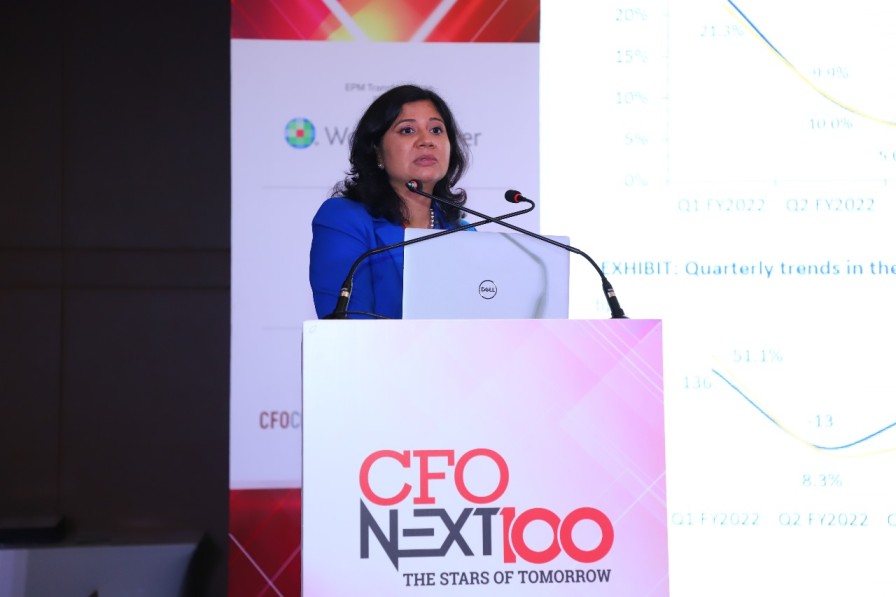- September 10, 2024
India’s growth puzzle: What lies ahead for the world’s fastest growing economy?

India’s economic growth continues to capture global attention, with its GDP growth rate solidifying its position as the fastest-growing major economy. However, recent figures have presented a complex picture, suggesting potential slowdowns amidst broader global economic concerns. Aditi Nayar, Chief Economist at ICRA, during one of the sessions at our recently concluded 13th annual CFONEXT100 Conference, offered a detailed breakdown of India’s growth performance and what to expect in the coming quarters.
A divergence in growth indicators
India’s GDP growth for the first quarter of FY25, from April to June, was recorded at 6.7%, cementing its status as the fastest-growing large economy globally. However, this figure reflects a slowdown from the previous quarter’s 7.8%. Nayar pointed out that this dip is particularly noteworthy when compared with a bottom-up metric – the Gross Value Added (GVA) – which tells a somewhat contrasting story.
GVA growth, after declining throughout last year, surprisingly picked up from 6.3% in Q4 to 6.8% in Q1 of FY25. This divergence between GDP and GVA raises questions about what metric offers a better sense of India’s true economic momentum. She suggested that GVA, which aggregates the contributions of agriculture, industry, and services, provides a more accurate picture of growth on the ground.
Transient slowdowns and uncertain recoveries
Nayar acknowledged several factors that have dampened GDP growth in Q1. An election quarter, reduced government capital spending, a heatwave impacting footfalls in retail, and slow rural demand have all contributed to the slowdown. However, she expressed cautious optimism that these issues are transient.
One particularly puzzling piece of the puzzle according to her was the unexpected surge in private final consumption expenditure (PFCE), which accelerated to 7.4% in Q1. This jump contrasts sharply with the more tepid 4% growth seen throughout the previous year. She questioned the sustainability of this increase, noting that it is not corroborated by corporate results in many sectors.
Rural and urban demand: The uneven recovery
The state of India’s rural and urban demand presents another layer of complexity. Nayar described the rural economy as showing some green shoots but lacking a convincing recovery in demand. However, a well-distributed monsoon and pent-up demand could offer a significant boost in the upcoming festive season. She remained hopeful that rural demand will see a sharp uptick in Q3, coinciding with the Diwali season.
Urban demand, in contrast, presents a more mixed picture. While consumer sentiment surged in the post-COVID period, recent indicators show a decline in both current and future sentiment indices. Nayar attributed this to several transient factors, such as reduced construction sector jobs and heatwaves, but also flagged concerns about long-term consumer confidence.
Capex cycles: Government vs private investment
The capital expenditure (capex) cycle is another key driver of India’s growth, with both government and private sectors playing a role. Nayar noted that government capex has been strong but was muted during the election months. With elections out of the way, she expects a pick-up in government spending, though warns that meeting ambitious targets within a narrow time frame might prove challenging.
On the private side, she highlighted a modest recovery in capex, particularly in sectors such as steel, cement, and data centres. However, she cautioned that the exuberant private capex cycles of the 2000s and 2010s are unlikely to return, with companies remaining cautious and focusing on realistic, measured investments.
Inflation and the impact on Monetary Policy
Inflation remains a significant concern for policymakers. Nayar forecasted that inflation will rise above 4% in the coming months, driven in part by food and fuel prices. She argued that inflation expectations are heavily influenced by these everyday essentials, making it unlikely that the RBI will shift its focus from headline to core inflation.
Despite easing in core inflation last year, she pointed out that this was largely due to falling commodity prices, rather than slack in the domestic economy. As commodity prices stabilize, core inflation is expected to rise once more, particularly in the services sector, where domestic demand is strong.
Looking ahead: Growth and challenges
For FY25, Nayar estimated a GDP growth of 7%, down from 8.2% the previous year. This forecast reflects a mix of transient slowdowns and more structural issues, such as weak rural demand and measured private capex. Over the medium term, she saw India’s growth potential in the range of 6.5% to 7%, with domestic consumption driving much of the expansion.
However, she warned that inflation could remain a persistent challenge, especially with food prices influenced by climate change and agro-climatic shocks. For policymakers, this may mean maintaining higher interest rates to keep inflation in check, even as growth rates remain robust.
Aditi Nayar’s insights paint a picture of an economy that is growing rapidly but faces a complex set of challenges. From uneven demand patterns and capex cycles to inflationary pressures and fiscal concerns, India’s economic future remains uncertain. Yet, as the fastest-growing large economy in the world, India’s trajectory is undoubtedly one to watch closely.
As she herself summarised, “Are we in an economy that is high growth but slowing down, or high growth but accelerating?” It seems that the answer to this question will depend on how India navigates these intersecting forces in the months ahead.
